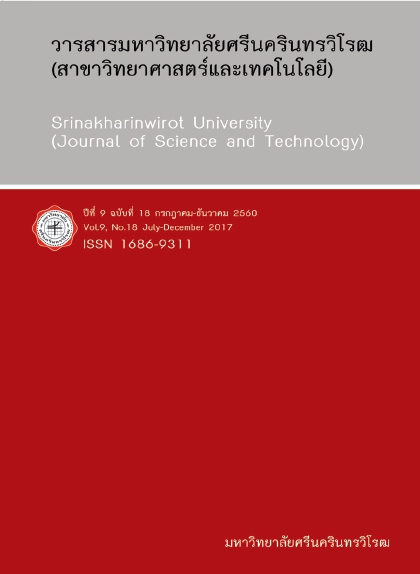การพัฒนาเครื่องมือช่วยจำลองการทำงานของขั้นตอนวิธีแบบมีโครงสร้าง (THE DEVELOPMENT OF A SIMULATION TOOL FOR STRUCTURED ALGORITHM)
Abstract
The objectives of this research are: 1) to develop the simulation tool for structured algorithm, and 2) to evaluate the simulation tool for structured algorithm. The research procedure is consisted of 5 steps as follows: The 1st step is analysis. The simulation tool’s components were analyzed. The 2nd step is design. The database, simulation’s procedures and screen were designed. The 3rd step is development. The simulation tool, questionnaires, and system documentation were created. The 4th step is implementation. The simulation tool was tested for improvement. The 5th step is evaluation. The simulation tool was assessed by 8 experts who were selected by purposive sampling.
The research results found that firstly, the simulation tool consisted of 5 parts as follows: 1) main menu, 2) button for paste algorithm command, 3) area for write algorithm, 4) data display area while simulate, and 5) scaffolding display area about algorithm. Secondly, the result of evaluated simulation tool by 8 experts found that the effectiveness was at the highest level ( = 4.54, S.D. = 0.58). In addition, the results of the qualitative data from the questionnaire indicated that the simulation tool for structured algorithm can be used for learning algorithm.
Downloads
References
ช่วยจำลองการทำงานของขั้นตอนวิธีแบบมีโครงสร้างโดยใช้ปัญหาเป็นหลักที่มีระบบเสริมศักยภาพบนเว็บ.
วารสารมหาวิทยาลัยศรีนครินทรวิโรฒ (สาขาวิทยาศาสตร์และเทคโนโลยี). 6(12): 91-105.
[2] Tomasz Muldner; & Elhadi Shakshuki. (2004). A New Approach to Learning Algorithms.
In International Conference on Information Technology Coding and Computer (ITCC’04).
1: 141-145.
[3] Elhadi M. Shakshuki; & Richard Halliday. (2009, May). An Agent for Web-based Structured
Hypermedia Algorithm Explanation System. Journal of Universal Computer Science. 15(10):
2078-2108.
[4] Gerald Futschek; & Julia Moschitz. (2010). Developing Algorithmic Thinking by Inventing and
Playing Algorithms. Constructionism. 1–10.
[5] Steven Hansen; N. Hari Narayanan; & Mary Hegarty. (2002). Designing Educationally Effective
Algorithm Visualizations. Journal of Visual Language and Computing. 291-317.
[6] Cristiane Camilo Hernandez; Luciano Silva; Rafael Alencar Segura; Juliani Schimiguel; Manuel
Fernandez Paradela Ledon; Luis Naito Mendes Bezerra; & Ismar Frango Silveira. (2010, August).
Teaching Programming Principles through a Game Engine. CLEI ELECTRONIC JOURNAL.
13(2): 1-8.
[7] Crescencio Bravo; Maria Jose Marcelino; Anabela Gomes; Micaela Esteves; & Antonio Jose Mendes.
(2005, September). Integrating Educational Tools for Collaborative Computer Programming
Learning. Journal of Universal Computer Science. 11(9): 1505-1517.
[8] Ari Korhonen; Lauri Malmi; Jussi Nikander; & Petri Tenhunen. (2003). Interaction and Feedback in
Automatically Assessed Algorithm Simulation Exercises. Journal of Information Technology
Education. 2: 241-255.
[9] Georgi Tuparov; Daniela Tuparova; & Vladimir Jordanov. (2014). Teaching sorting and searching
algorithms through simulation-based learning objects in an introductory programming course.
Procedia - Social and Behavioral Sciences. 116: 2962-2966.
[10] Samer Al-lmamy; Javanshir Alizadeh; & Mohamed A. Nour. (2006). On the Development of a
Programming Teaching Tool: The Effect of Teaching by Templates on the Learning Process.
Journal of Information Technology Education. 5: 271–283.
[11] Gerald Futschek. (2006). Algorithmic Thinking: The Key for Understanding Computer Science.
Springer. 159–168.
[12] Mohd Nasir ISMAIL; Nor Azilah NGAH; & Irfan Naufal UMAR. (2010, April). Instructional Strategy in The Teaching of Computer Programming: A Need Assessment Analyses. The Turkish Online
Journal of Education Technology. 9(2): 125-131. Retrieved March 10, 2012, from
http://tojet.net/articles/v9i2/9214.pdf
[13] Sebastien COMBEFIS; Virginie VAN den SCHRIECK; & Alexis NOOTEENS. (2013). Growing
Algorithmic Thinking Through Interactive Problems to Encourage Learning Programming.
Olympiads in Informatics. 7: 3-13.
[14] Stuart Garner. (2003, June). Learning Resources and Tools to Aid Novices Learn Programming.
Informing Science. 213–222.
[15] สำนักงานคณะกรรมการการศึกษาแห่งชาติ สำนักนายกรัฐมนตรี. (2542). พระราชบัญญัติการศึกษา
แห่งชาติ. กรุงเทพฯ: คุรุสภา ลาดพร้าว.
[16] Elhadi M. Shakshuki; & Richard Halliday. (2009). An Agent for Web-based Structured Hypermedia
Algorithm Explanation System. Journal of Universal Computer Science. 15(1): 2078-2108.
[17] Thomas A. Brush & John W. Saye. (2002). A Summary of Research Exploring Hard and Soft
Scaffolding for Teachers and Students Using a Multimedia Supported Learning Environment.
The Journal of Interactive Online Learning. 1(2): 1-12.
[18] ทิศนา แขมมณี. (2553). ศาสตร์การสอนองค์ความรู้เพื่อการจัดกระบวนการเรียนรู้ที่มีประสิทธิภาพ.
กรุงเทพฯ: สำนักพิมพ์แห่งจุฬาลงกรณ์มหาวิทยาลัย.
Downloads
Published
How to Cite
Issue
Section
License
Srinakharinwirot University Journal of Sciences and Technology is licensed Under a Creative Commons Attribution-NonCommercial-NoDerivs 4.0 International (CC-BY-NC-ND 4.0) License, Unless Otherwise Stated. Please Read Journal Policies Page for More Information on Open Access, Copyright and Permissions.


